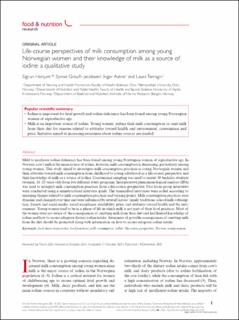| dc.contributor.author | Henjum, Sigrun | |
| dc.contributor.author | Groufh-Jacobsen, Synne | |
| dc.contributor.author | Aakre, Inger | |
| dc.contributor.author | Terragni, Laura | |
| dc.coverage.spatial | Norway | en_US |
| dc.date.accessioned | 2022-02-22T11:39:32Z | |
| dc.date.available | 2022-02-22T11:39:32Z | |
| dc.date.created | 2021-12-15T10:33:23Z | |
| dc.date.issued | 2021-12-14 | |
| dc.identifier.citation | Food & Nutrition Research. 2021, 65 . | en_US |
| dc.identifier.issn | 1654-6628 | |
| dc.identifier.issn | 1654-661X | |
| dc.identifier.uri | https://hdl.handle.net/11250/2980761 | |
| dc.description.abstract | Mild to moderate iodine deficiency has been found among young Norwegian women of reproductive age. In Norway, cow’s milk is the main source of iodine; however, milk consumption is decreasing, particularly among young women. This study aimed to investigate milk consumption practices in young Norwegian women and their attitudes toward milk consumption from childhood to young adulthood in a life-course perspective and their knowledge of milk as a source of iodine. Convenience sampling was used to recruit 30 bachelor students (women, 18–25 years old) from five different study programs. Interpretative phenomenological analysis (IPA) was used to interpret milk consumption practices from a life-course perspective. Five focus group interviews were conducted using a semistructured interview guide. The transcribed interviews were coded according to emerging themes related to milk consumption practices and turning points. Milk consumption practices were dynamic and changed over time and were influenced by several factors: family traditions, school milk subscription, friends and social media, social acceptance, availability, price, and attitudes toward health and the environment. Young women tend to be in a phase of life in which milk is not part of their food practices. Most of the women were not aware of the consequences of omitting milk from their diet and had limited knowledge of iodine and how to secure adequate dietary iodine intake. Awareness of possible consequences of omitting milk from the diet should be promoted along with information on how to secure adequate iodine intake. | en_US |
| dc.language.iso | eng | en_US |
| dc.publisher | Swedish Nutrition Foundation | en_US |
| dc.relation.ispartofseries | Food & Nutrition Research;Vol 65 (2021) | |
| dc.rights | Navngivelse 4.0 Internasjonal | * |
| dc.rights.uri | http://creativecommons.org/licenses/by/4.0/deed.no | * |
| dc.subject | Food choice trajectories | en_US |
| dc.subject | Food practices | en_US |
| dc.subject | Milk consumption | en_US |
| dc.subject | Iodine | en_US |
| dc.subject | Life-course perspectives | en_US |
| dc.subject | Young women | en_US |
| dc.title | Life-course perspectives of milk consumption among young Norwegian women and their knowledge of milk as a source of iodine: a qualitative study | en_US |
| dc.type | Peer reviewed | en_US |
| dc.type | Journal article | en_US |
| dc.description.version | publishedVersion | en_US |
| dc.rights.holder | © 2021 Sigrun Henjum et al. | en_US |
| dc.source.articlenumber | 7758 | en_US |
| cristin.ispublished | true | |
| cristin.fulltext | original | |
| cristin.qualitycode | 1 | |
| dc.identifier.doi | https://doi.org/10.29219/fnr.v65.7758 | |
| dc.identifier.cristin | 1968696 | |
| dc.source.journal | Food & Nutrition Research | en_US |
| dc.source.volume | 65 | en_US |
| dc.source.pagenumber | 9 | en_US |

